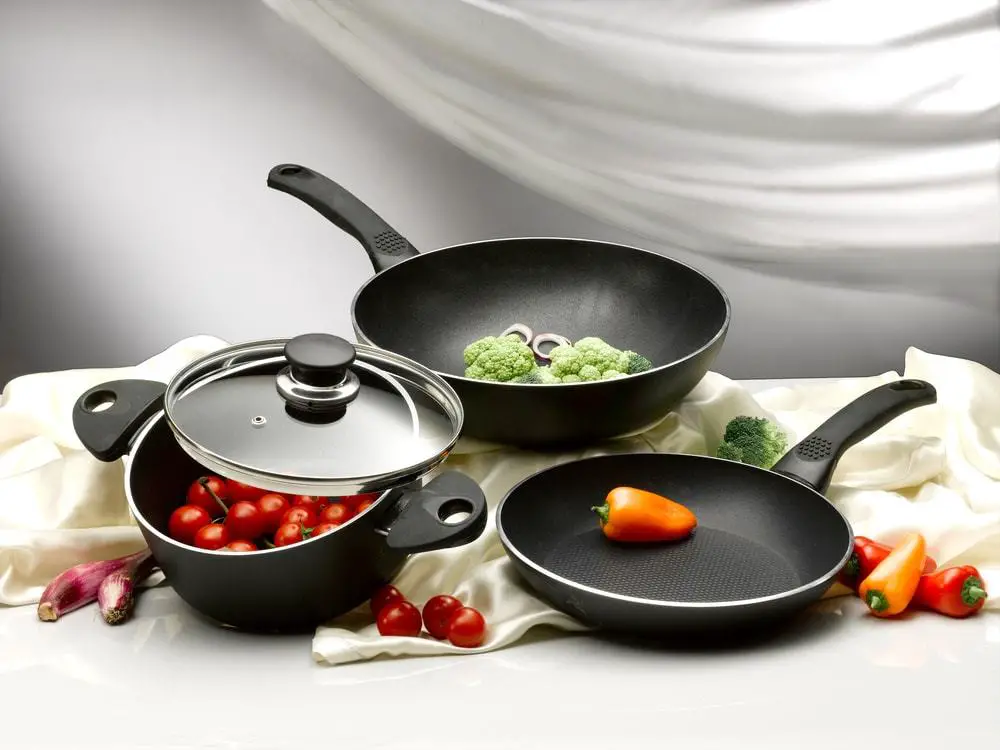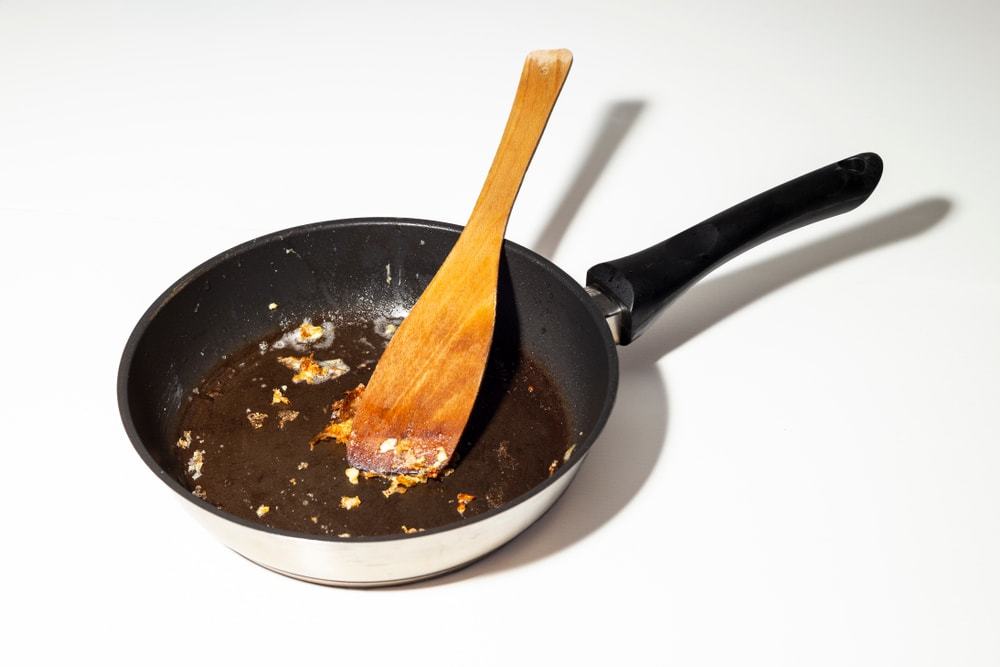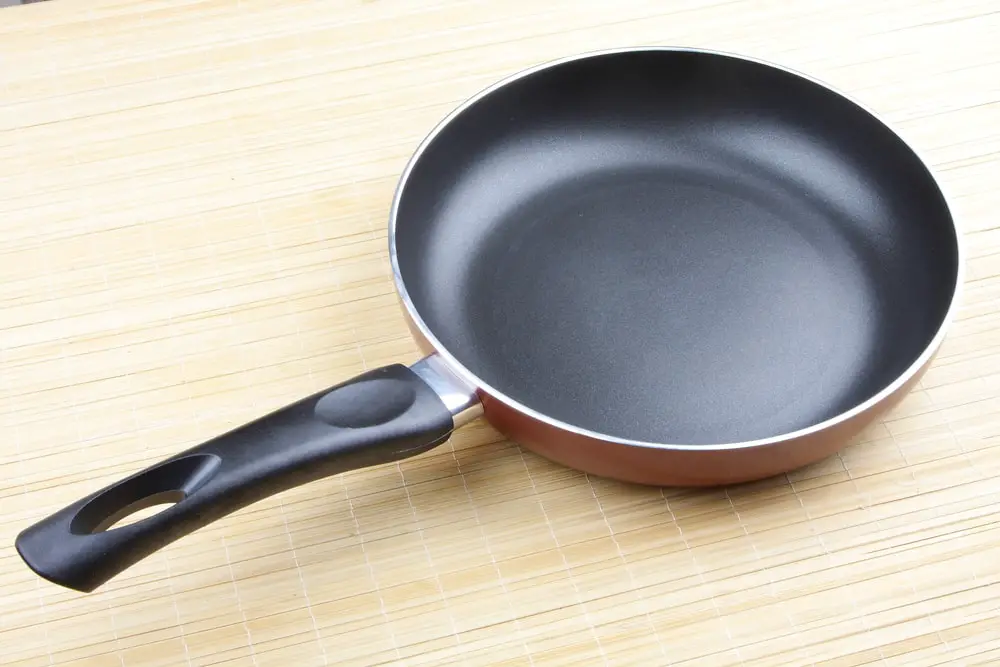This post contains affiliate links. When you buy through our links, we may earn a commission.
Nonstick pan has become very popular because of its maintenance properties. When used to prepare a meal, it is not sticky and this is the reason for its name. It can be cleaned up within a twinkle of an eye and it is quite lightweight.
However, there is a problem that is peculiar to all types of non-stick pans. Non-stick pans tend to lose a bit of their non-stick properties over time. The more they are used, the higher the chances of it sticking to the food or meal that is been prepared. This explains why it is important to know how to season the non-stick pan.
- What is a non-stick pan?
- What causes a non-stick pan to lose its non-stick qualities?
- What does it mean to Season a Nonstick Pan?
- How to Season a Nonstick Pan for the first time
- When should I Season a Nonstick Pan?
- Do You Need to Season Nonstick Frying Pan before Use?
- What would happen if I don’t?
- Can you Season a Nonstick Pan with olive oil?
- What to do to Season a Nonstick Pan
- Can you season a Teflon pan?
What is a non-stick pan?
We all know how frustrating it could be when you are trying to fry eggs, omelets, or pancakes but you seem not to have control over it due to a sticky pan or pot. It does not only bring frustration, but it also wastes your time. Apart from that, the quality of the food will be affected and you would be tagged as a bad cook. This is so because these foods do not require too much oil. This was the problem a non-stick-pan was created to solve.

The coatings used on the surface of non-stick pans have evolved over the years. A few years back, it did not take long for the surface of a non-stick pan to become distorted. The loss of non-stick properties happened rather fast usually within a few months of first use or purchase. This was what pushed people to look for ways on how to season the non-stick pan. The ease at which non-stick pans lost their built-in abilities did not give the brand a good name or market value. In fact, before now, non-stick pans were often regarded as inferior and cheap.
However, times have changed and there has been an improvement. Advancements in technology have made it possible to produce standard non-stick pans that would stand the test of time. These products are now made from quality metals and have become sturdier.
It is now possible to use non-stick pans under high heat and low heat conditions. If you have an issue with the performance and effectiveness of your non-stick pan, this article is for you. We will be lifting the lid on how to season pans. Seasoning non-stick pans have become easier and more flexible.
By seasoning a non-stick pan, you add to its durability and longevity. Also, the surface will be as slippery as it should be hence making it easier for you to prepare your favorite meals and delicacies.
What causes a non-stick pan to lose its non-stick qualities?

There are so many things that could cause such a pan to lose all or some of its non-stick properties. When a dent occurs on the surface of the pan as a result of a scratch or stains, it loses its non-stick tendencies. The cooking surface of many a non-stick pan is usually characterized by a black inner surface. This is known as a seasoning and it is done for a reason – to revive the non-stick ability of the pan.
What does it mean to Season a Nonstick Pan?
Seasoning is the process of applying oil to the surface of a frying or cooking pan. The oil used could be a vegetable oil or any other similar oil with reasonable viscosity. In chemistry, there is something called polymerization and it is this principle that is applied here.
The oil that is poured on the surface of the oil is heated to a very high temperature until it is in sync with the surface of the pan. This trick also helps to prevent rust from forming on the surface of the pan.
How to Season a Nonstick Pan for the first time
Before we take a look at some of the best practices as far as seasoning a frying pan is concerned, let us take a look at what it means to season a pan.
Many people are of the opinion that there is no point in seasoning a non-stick pan since it is already coated for this reason. On the other hand, the fact that some of the coatings are lost overtime increases the need to make a non-stick pan non-stick again.
When should I Season a Nonstick Pan?
It is important to season a non-stick pan when it is becoming obvious that food is sticking on its surface. Also, the volume of oil used to prepare a particular portion of food will increase steadily.
This is not only a signal that the pan has lost some of its non-stick properties; it is also an indication that it needs to be seasoned. So, you may want to learn how to season a pan for the first time to keep it in check and to preserve both the quality of food preparation but also the volume of vegetable oil required to make a specific portion of food.
You may not want to season a non-stick pan immediately after purchase. However, if you notice a drop in its performance or some of the signs earlier listed, you may want to consider seasoning the pan.
Do You Need to Season Nonstick Frying Pan before Use?
Seasoning a non-stick pan should only be done when it is beginning to lose some of its non-stick properties. You may not need to season the frying pan before every use.
What would happen if I don’t?
If you fail to season a non-stick pan that has become sticky, you could ruin your food. The food will be glued to the surface of the pan and it won’t be edible anymore.
Can you Season a Nonstick Pan with olive oil?
There is no hard and fast rule concerning the choice of oil for seasoning a non-stick pan. Vegetable oil or olive oil can be used as long as it has the desired viscosity and it can polymerize easily.
What to do to Season a Nonstick Pan
If you are keen to learn how to season pans, this is the part that should interest you most. Seasoning a pan is not rocket science. It only involves strict adherence and compliance with a few procedures. Whether you have seasoned a pan before or you want to know how to season a pan for the first time, you will find this very useful.
-
- To season a non-stick pan, you must first make sure it is clean and free from dirt. Washing the pan will also help to get rid of residual oil on the surface.
- After washing, you must ensure there is no moisture content on the pan. Make sure it is completely dry. The presence of water or any other liquid on the pan will hinder the seasoning process.
- If you would be using an oven for the seasoning process, make sure it is preheated to about 149 degrees centigrade.
- After that, pour an appropriate amount of the desired oil on the surface of the pan and apply enough heat until polymerization takes place. Polymerization simply implies that the applied oil dries up or is in sync with the surface of the pan.
- After this is done, you would want to put the pan in an oven as its surface is already oiled. The pan should remain in the oven for about forty-five minutes to one hour.
- When the time elapses, you may withdraw the pan from the oven and allow it to cool for a while. This signifies the end of the seasoning process.
Apart from an oven, there is also the option of making use of a stove to season non-stick pans. The whole procedure and steps are the same.
The only dichotomy is that we are using a completely different source of heat. So, as with the oven method, you want to apply oil to the surface of the pan and place it on the stove.
You must pay proper attention to the stove to prevent overheating from taking place. When the applied oil dries off, you can withdraw the pan from the stove so that it does not become too hot. After that, leave it for some time to cool off and eliminate any excess oil floating on the surface.

Furthermore, it is important to note that the method of seasoning a non-stick pan varies from one manufacturer to another. Therefore, it would be better to ensure strict compliance with the recommended guideline from the product manufacturer as far as the seasoning is concerned.
For improved performance and greater efficiency, you may want to repeat the procedure several times until a high quality coating is achieved. While this may look like an absolute waste of time and resources, it is a logical and reasonable thing to do because it improved the durability and extends the lifespan of your non-stick pan.
Can you season a Teflon pan?
Yes. It is very possible to season a Teflon pan just like all other non-stick pans.
How to Clean and Care for your non-stick Frying Pan?
It is important to keep your non-stick pan free from dirt and dust. Often times, the loss of non-stick properties is caused by the presence of dirt and impurities. Hence it is important to always wash your pan immediately after use or if it has been left unused for a very long period of time.
Wrapping up!
Are you tired of burnt food or scrapping substantive portion of food from the surface of a non-stick pan, seasoning non-stick pan is the solution to your problem. It is the perfect answer to all your non-stick queries and it is a very cheap and inexpensive way to revive or return the non-stick qualities of your pan whether it is an old one or a pan that you recently purchased.
Follow the aforementioned steps for the output you desire from your pan.
If you have always wanted to learn how to season a non-stick pan, strict adherence and compliance with this procedure will stand you in good stead and help you achieve the desired result within a little time.
